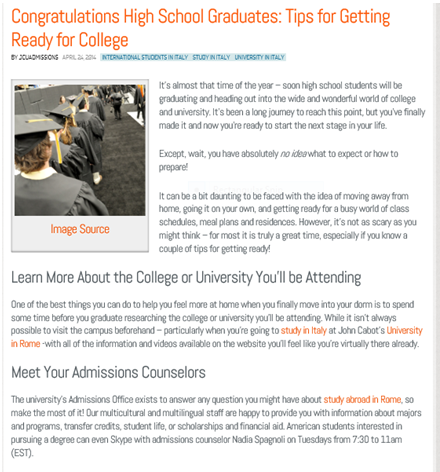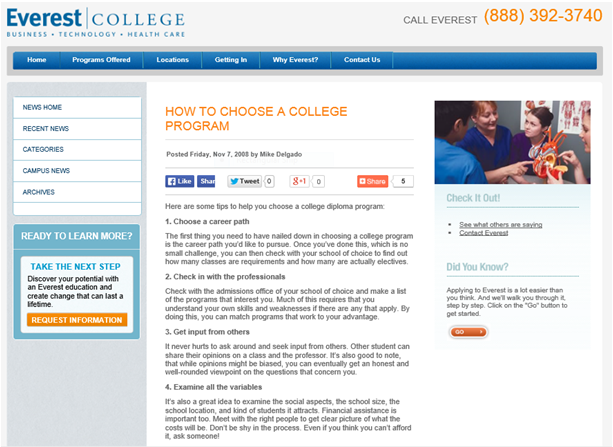
Our ‘information age’ is characterized by the breakneck speed at which data is disseminated, shared, consumed, and discarded. We demand constant updates; we must be in the know. The continually shifting sands of technology, trends, and consumer preferences mean that conventional content must be updated all the time. Standard higher education marketing strategy relies on frequent tweets, blogs, and posts to reach out to students and generate new leads– but most of this content remains relevant for only a day or two before evaporating into the internet ether. How can you better extend its shelf-life and leverage its power?
Enter the Evergreen philosophy. It’s precisely what the name suggests: information or reference material that never goes out of date. It remains relevant, actionable, fresh, and enduring over long periods of time. Because it doesn’t go out of style, Evergreen material is likely to continue receiving traffic from search engines and directories long after it’s been published. It’s truly low-maintenance content leveraging that can serve to establish your college as a trusted source of valuable knowledge.
The Higher Ed “How To” and the “Short-List”
Evergreen content informs, entertains, and endures, addressing the core concerns of prospective and current students – providing material across multiple channels that speaks to perennial issues like funding, exam stress, and selecting the right program. Both prospective and current students tend to seek out the same type of information year after year. They’re looking for answers to enduring questions like how to survive their first year of college, or the secrets of successful studying. Easy-to-access “how to’s” and short-list formats are a great way of packaging perennially relevant content – advice that keeps site visitors informed and entertained year after year.
For example, advice on how to cope with exam stress never gets old. The fundamentals of ‘keep calm and carry on’ are universal – guidance that students will continue to seek out, year after year. This YouTube video from the University of Alberta is a good example of “how to” Evergreen content that addresses the issue of test anxiety:

The John Cabot University blog also taps into the recurring themes of student life by featuring a strategic combination of campus news, program highlights, and Evergreen list-posts like this one for recent high school grads:

And here’s another example from Everest College. They published a short-list article on how to choose a college program and linked it to their program description page. It may be dated 2008, but the information is essentially timeless:

Whether it’s a video, web article, or blog post – investing in an Evergreen content strategy yields dependable returns. This type of recurrently visible material really sets the tone for your college, defines your brand, and keeps your target audience coming back for more.
Provide Student Support: Don’t Push the Product
What the above examples all have in common is their focus on student needs, versus the overt promotion of academic packages. In order to be effective and truly long-lasting, Evergreen content must make an emotional connection with its audience. The material, no matter its form, should also be pertinent, useful to your leads and to your current students.
In addition to the “how to” and short-list format, there are a range of Evergreen options that can be carefully crafted with your specific audience in mind:
- Testimonials
- Career Guidance & Industry Resources
- Tutorials
- Frequently Asked Questions (FAQs)
Show Don’t Tell With Visual Branding
Higher education Evergreen content is about helping and informing students, rather than repeatedly naming your product and extolling its virtues. But that doesn’t mean that your brand is invisible. Who you are as a school is inextricably linked to the content you provide on your website and post on your social media channels – and with logos and images, that identity is reinforced by strategic visual college branding.
Here’s a Niagara College example of informative FAQs with effective visual branding:

The interactive FAQ tool is designed to be easy for students to use, featuring a top 10 list of their most common concerns – it even promises a kind of third party objectivity by sourcing answers from beyond the Niagara College website.
The student is clearly front and center here; however, the strategic placement of the college “NC” logo in several places throughout the web page provides a constant reminder of who created this particular piece of Evergreen content – and who can be trusted to provide for student needs.
Know Your Student Persona Profile
At its core, Evergreen content is about establishing a human connection, fulfilling a need, and responding to a concern. To make this happen, higher education marketers must develop a “persona profile” for their leads, an understanding of what makes those particular students tick – and click. Only then can we produce material students want to come back to and share, over and over again. Now that’s a gift that keeps on giving.

Do you understand the persona profile of your leads well enough to craft truly compelling Evergreen content?





